How to avoid falling for scams like "Truist Online Banking Profile"
![]() Written by Tomas Meskauskas on (updated)
Written by Tomas Meskauskas on (updated)
What is "Truist Online Banking Profile"?
This email has been identified as a fraudulent communication, specifically a phishing attempt orchestrated by scammers seeking to obtain sensitive information from recipients. Their objective is to deceive recipients into opening the attached file and providing the requested information. Therefore, it is strongly advised that recipients disregard this email.
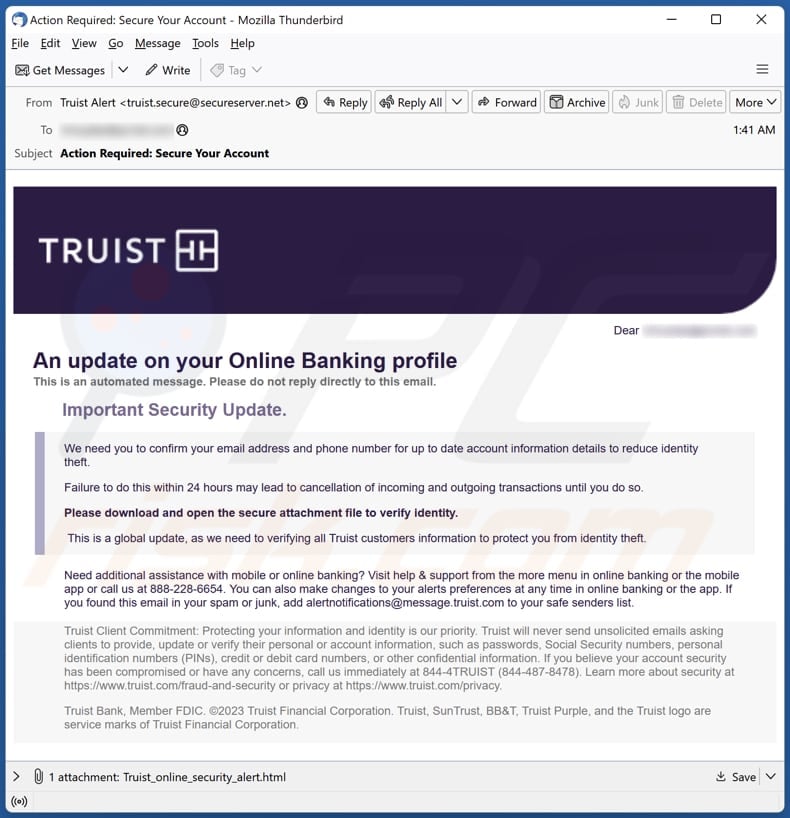
More about the "Truist Online Banking Profile" scam email
The phishing email presents itself as an automated message related to the recipient's online banking profile. It claims to be an important security update, urging the recipient to confirm their email address and phone number to ensure up-to-date account information and reduce the risk of identity theft.
The message emphasizes a time-sensitive nature, warning that failure to comply within 24 hours could result in the cancellation of incoming and outgoing transactions. In order to verify identity, recipients are instructed to download and open a secure attachment file.
The email asserts a global update for all Truist customers, positioning the information verification as a measure to protect customers from identity theft. It is important to note that Truist is a legitimate bank not associated with this scam.
The file attached to this email ("Truist_online security_alert.html", its name may vary) contains a fake Truist bank login form requesting to provide the user ID and password to sign in. Upon obtaining login credentials through the fake Truist bank login form, scammers can embark on various malicious activities.
This includes initiating unauthorized transactions, potentially transferring funds to controlled accounts, engaging in identity theft by impersonating the victim for fraudulent endeavors and seizing control of the entire bank account.
In order to mitigate such risks, individuals are strongly advised to remain vigilant against phishing attempts, safeguard their login credentials diligently, and promptly report any suspicious activities to their financial institution.
| Name | Truist Online Banking Profile Email Scam |
| Threat Type | Phishing, Scam, Social Engineering, Fraud |
| Fake Claim | Recipients must confirm their email address or phone number |
| Attachment | Truist_online_security_alert.html (filename may vary) |
| Detection Names (Attachment) | Avast (Other:SNH-gen [Phish]), AVG (Other:SNH-gen [Phish]), Fortinet (JS/Phishing.AMEX!tr), Ikarus (Win32.SuspectCrc), Microsoft (Trojan:Win32/Phonzy.B!ml), Full List Of Detections (VirusTotal) |
| Disguise | Letter from Truist bank |
| Symptoms | Unauthorized online purchases, changed online account passwords, identity theft, illegal access of the computer. |
| Distribution methods | Deceptive emails, rogue online pop-up ads, search engine poisoning techniques, misspelled domains. |
| Damage | Loss of sensitive private information, monetary loss, identity theft. |
| Malware Removal (Windows) | To eliminate possible malware infections, scan your computer with legitimate antivirus software. Our security researchers recommend using Combo Cleaner. |
Similar scam emails in general
Emails of this kind typically impersonate legitimate institutions, such as banks, and use urgency or security concerns to prompt immediate action. Common elements include the request for sensitive information, a sense of urgency threatening consequences for non-compliance, and a call to action that involves clicking on links or downloading attachments.
Additionally, these emails may exhibit generic or impersonal salutations and may contain grammatical errors. The ultimate goal is to deceive recipients into divulging personal information, such as login credentials, which can be exploited for financial fraud, identity theft, or other malicious activities.
Examples of similar emails are "Password Needs To Be Retained Urgently", "IMAP Termination Process", and "Aknowledged Response". It is important to be aware that attachments and links received from cybercriminals can be malicious.
How do spam campaigns infect computers?
Users infect their computers through email by interacting with malicious elements such as attachments or embedded links. Cybercriminals disguise malware within seemingly harmless attachments, which, when opened, can inject malware into computers. Clicking on links embedded within emails can also lead to the download and execution of malware.
Cybercriminals commonly use executable and JavaScript files or exploit document formats like PDFs or Office documents to distribute malware via email. Other files frequently used to distribute malware are ISO files and archives like ZIP or RAR.
How to avoid installation of malware?
Avoid opening attachments or links in suspicious (e.g., irrelevant or unexpected) emails from unknown addresses. Keep your operating system, installed programs, and antivirus software updated, and perform regular scans on your computer. Be cautious when downloading files and programs from the internet, and only use trusted sources, such as official pages and app stores.
Avoid interacting with questionable content (e.g., shady ads, pop-ups, offers, software updates) while visiting dubious websites. Do not download pirated software, cracking tools, or key generators. If you have already opened malicious attachments, we recommend running a scan with Combo Cleaner Antivirus for Windows to automatically eliminate infiltrated malware.
Text presented in the "Truist Online Banking Profile" email letter:
Subject: Action Required: Secure Your Account
Truist
Dear ********
An update on your Online Banking profile
This is an automated message. Please do not reply directly to this email.
Important Security Update.We need you to confirm your email address and phone number for up to date account information details to reduce identity theft.
Failure to do this within 24 hours may lead to cancellation of incoming and outgoing transactions until you do so.
Please download and open the secure attachment file to verify identity.
This is a global update, as we need to verifying all Truist customers information to protect you from identity theft
Fake website promoted via this phishing campaign:
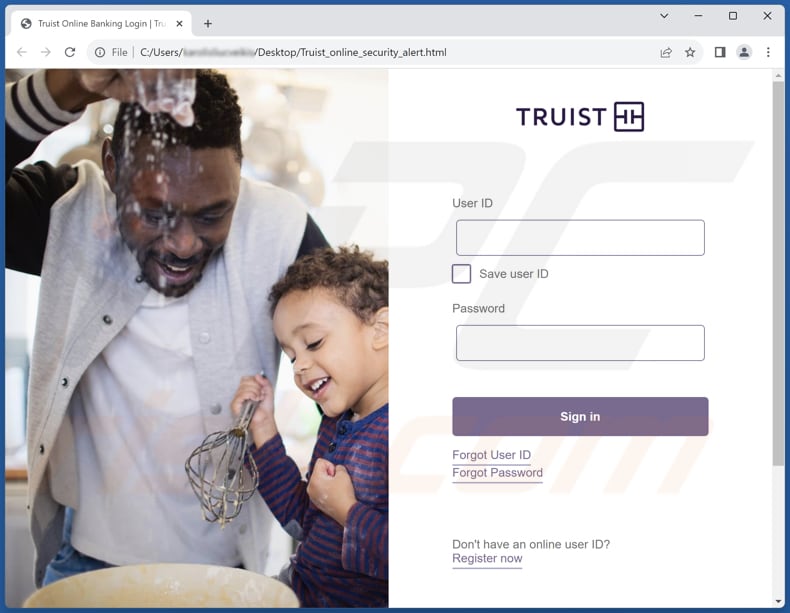
Another example of phishing HTML document distributed using this spam campaign:
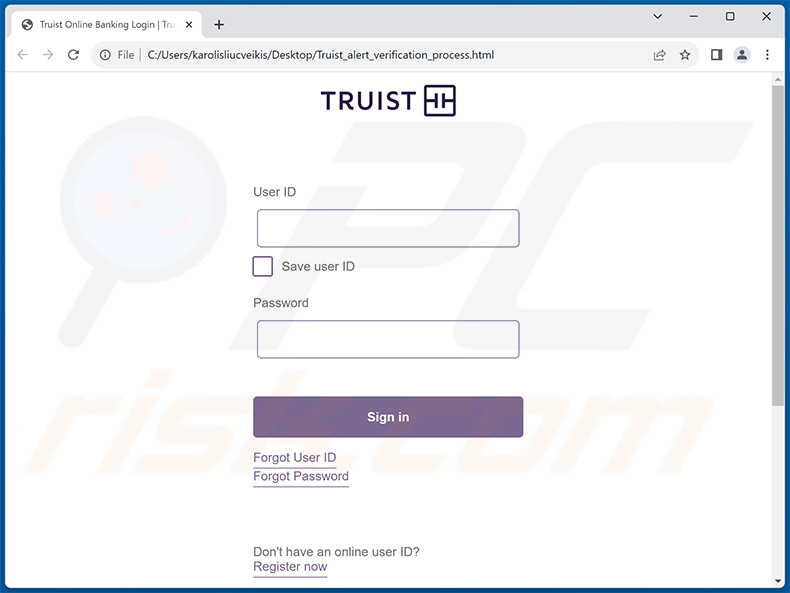
Another example of an email from "Truist Online Banking Profile" spam campaign:
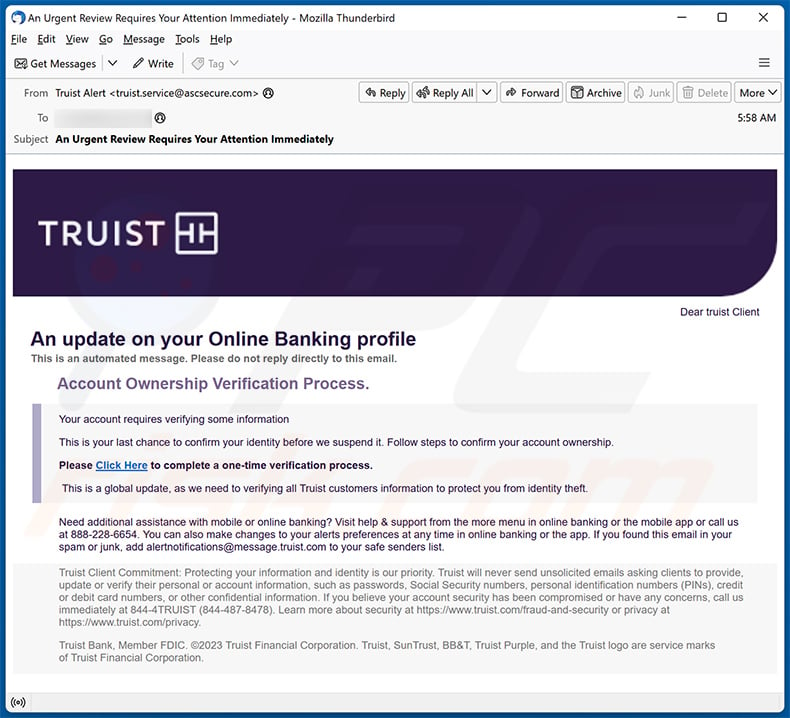
Text presented within:
Subject:An Urgent Review Requires Your Attention Immediately
Dear truist Client
An update on your Online Banking profile
This is an automated message. Please do not reply directly to this email.
Account Ownership Verification Process.Your account requires verifying some information
This is your last chance to confirm your identity before we suspend it. Follow steps to confirm your account ownership.
Please Click Here to complete a one-time verification process.
This is a global update, as we need to verifying all Truist customers information to protect you from identity theft.
Screenshot of the promoted phishing site:
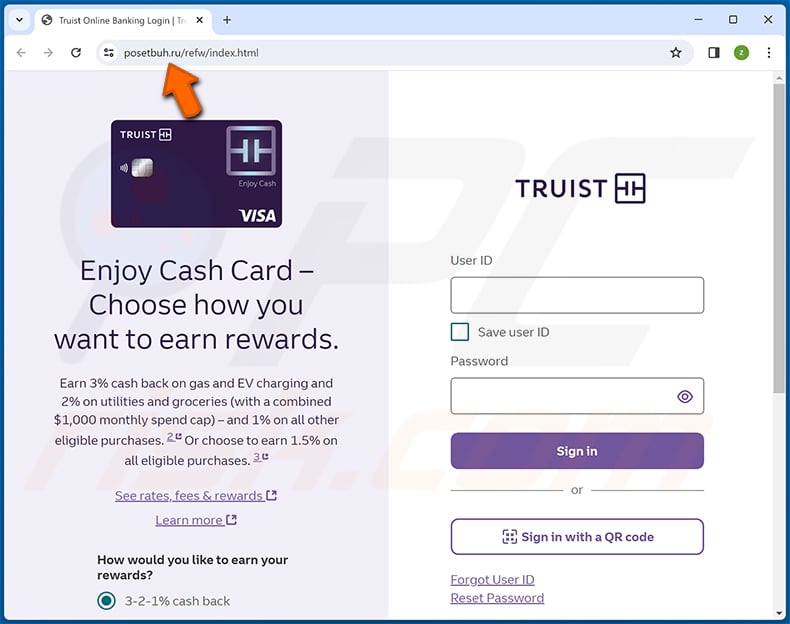
Yet another example of an email from "Truist Online Banking Profile" spam campaign:
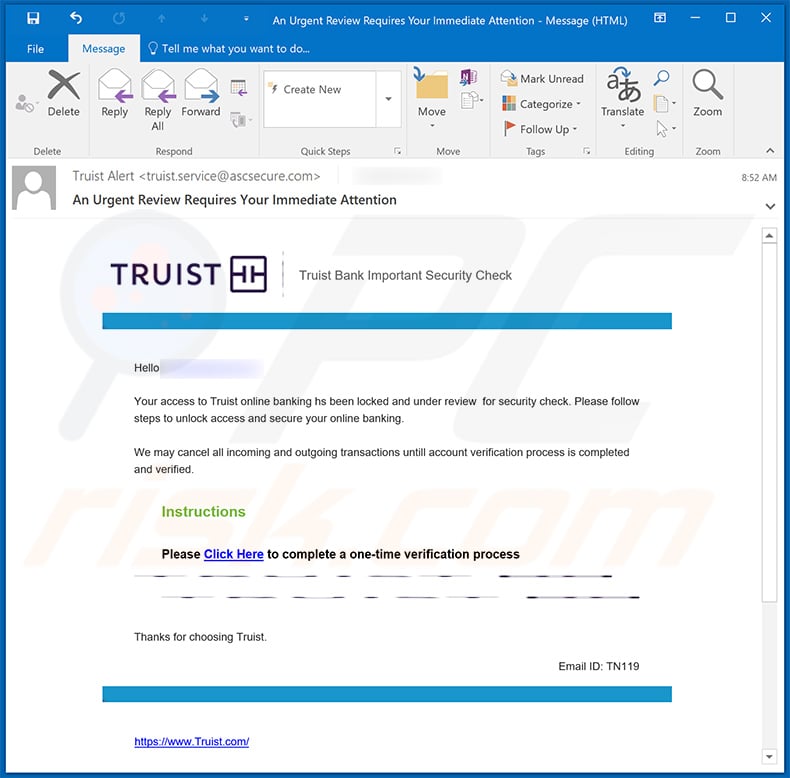
Text presented within:
Subject: An Urgent Review Requires Your Immediate Attention
TRUIST
Truist Bank Important Security Check
Hello -,
Your access to Truist online banking hs been locked and under review for security check. Please follow steps to unlock access and secure your online banking.
We may cancel all incoming and outgoing transactions untill account verification process is completed and verified.
Instructions
Please Click Here to complete a one-time verification processThanks for choosing Truist.
Yet another example of a Truist-themed spam email promoting a phishing site:
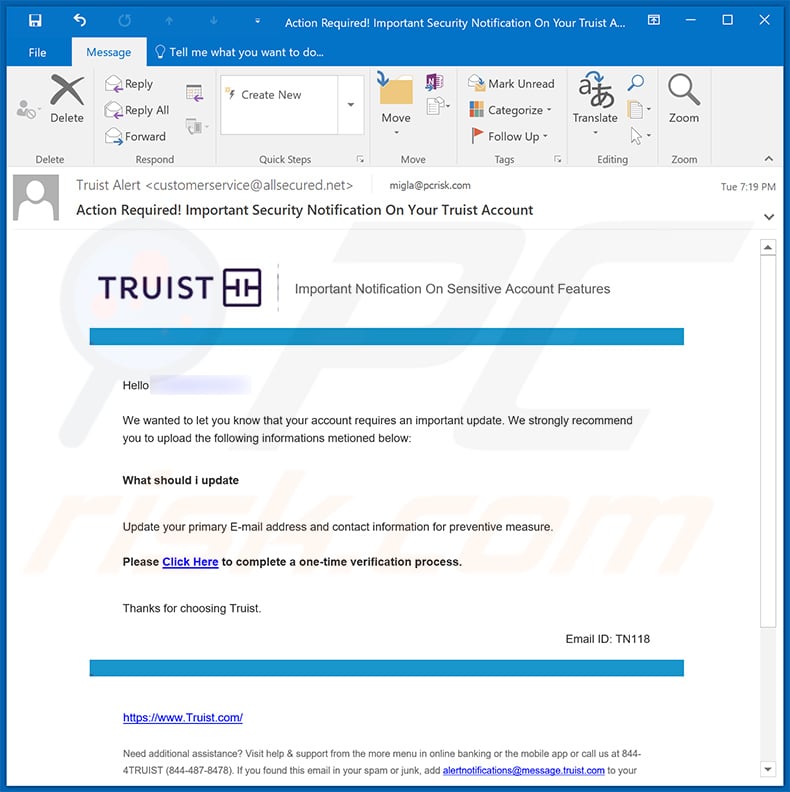
Text presented within:
Subject: Action Required! Important Security Notification On Your Truist Account
TRUIST
Important Notification On Sensitive Account Features
Hello ********,We wanted to let you know that your account requires an important update. We strongly recommend you to upload the following informations metioned below:
What should i update
Update your primary E-mail address and contact information for preventive measure.Please Click Here to complete a one-time verification process.
Thanks for choosing Truist.
Instant automatic malware removal:
Manual threat removal might be a lengthy and complicated process that requires advanced IT skills. Combo Cleaner is a professional automatic malware removal tool that is recommended to get rid of malware. Download it by clicking the button below:
▼ DOWNLOAD Combo Cleaner
By downloading any software listed on this website you agree to our Privacy Policy and Terms of Use. To use full-featured product, you have to purchase a license for Combo Cleaner. 7 days free trial available. Combo Cleaner is owned and operated by Rcs Lt, the parent company of PCRisk.com read more.
Quick menu:
- What is Truist Online Banking Profile phishing campaign?
- Types of malicious emails.
- How to spot a malicious email?
- What to do if you fell for an email scam?
Types of malicious emails:
![]() Phishing Emails
Phishing Emails
Most commonly, cybercriminals use deceptive emails to trick Internet users into giving away their sensitive private information, for example, login information for various online services, email accounts, or online banking information.
Such attacks are called phishing. In a phishing attack, cybercriminals usually send an email message with some popular service logo (for example, Microsoft, DHL, Amazon, Netflix), create urgency (wrong shipping address, expired password, etc.), and place a link which they hope their potential victims will click on.
After clicking the link presented in such email message, victims are redirected to a fake website that looks identical or extremely similar to the original one. Victims are then asked to enter their password, credit card details, or some other information that gets stolen by cybercriminals.
![]() Emails with Malicious Attachments
Emails with Malicious Attachments
Another popular attack vector is email spam with malicious attachments that infect users' computers with malware. Malicious attachments usually carry trojans that are capable of stealing passwords, banking information, and other sensitive information.
In such attacks, cybercriminals' main goal is to trick their potential victims into opening an infected email attachment. To achieve this goal, email messages usually talk about recently received invoices, faxes, or voice messages.
If a potential victim falls for the lure and opens the attachment, their computers get infected, and cybercriminals can collect a lot of sensitive information.
While it's a more complicated method to steal personal information (spam filters and antivirus programs usually detect such attempts), if successful, cybercriminals can get a much wider array of data and can collect information for a long period of time.
![]() Sextortion Emails
Sextortion Emails
This is a type of phishing. In this case, users receive an email claiming that a cybercriminal could access the webcam of the potential victim and has a video recording of one's masturbation.
To get rid of the video, victims are asked to pay a ransom (usually using Bitcoin or another cryptocurrency). Nevertheless, all of these claims are false - users who receive such emails should ignore and delete them.
How to spot a malicious email?
While cyber criminals try to make their lure emails look trustworthy, here are some things that you should look for when trying to spot a phishing email:
- Check the sender's ("from") email address: Hover your mouse over the "from" address and check if it's legitimate. For example, if you received an email from Microsoft, be sure to check if the email address is @microsoft.com and not something suspicious like @m1crosoft.com, @microsfot.com, @account-security-noreply.com, etc.
- Check for generic greetings: If the greeting in the email is "Dear user", "Dear @youremail.com", "Dear valued customer", this should raise suspiciousness. Most commonly, companies call you by your name. Lack of this information could signal a phishing attempt.
- Check the links in the email: Hover your mouse over the link presented in the email, if the link that appears seems suspicious, don't click it. For example, if you received an email from Microsoft and the link in the email shows that it will go to firebasestorage.googleapis.com/v0... you shouldn't trust it. It's best not to click any links in the emails but to visit the company website that sent you the email in the first place.
- Don't blindly trust email attachments: Most commonly, legitimate companies will ask you to log in to their website and to view any documents there; if you received an email with an attachment, it's a good idea to scan it with an antivirus application. Infected email attachments are a common attack vector used by cybercriminals.
To minimise the risk of opening phishing and malicious emails we recommend using Combo Cleaner Antivirus for Windows.
Example of a spam email:

What to do if you fell for an email scam?
- If you clicked on a link in a phishing email and entered your password - be sure to change your password as soon as possible. Usually, cybercriminals collect stolen credentials and then sell them to other groups that use them for malicious purposes. If you change your password in a timely manner, there's a chance that criminals won't have enough time to do any damage.
- If you entered your credit card information - contact your bank as soon as possible and explain the situation. There's a good chance that you will need to cancel your compromised credit card and get a new one.
- If you see any signs of identity theft - you should immediately contact the Federal Trade Commission. This institution will collect information about your situation and create a personal recovery plan.
- If you opened a malicious attachment - your computer is probably infected, you should scan it with a reputable antivirus application. For this purpose, we recommend using Combo Cleaner Antivirus for Windows.
- Help other Internet users - report phishing emails to Anti-Phishing Working Group, FBI’s Internet Crime Complaint Center, National Fraud Information Center and U.S. Department of Justice.
Frequently Asked Questions (FAQ)
Why did I receive this email?
Phishing emails are commonly dispatched to a wide range of recipients, intending to deceive them into revealing sensitive information like login credentials or financial details. Cybercriminals employ this broad approach, hoping that some individuals within the targeted audience will be lured into the fraudulent scheme.
I have provided my personal information when tricked by this email, what should I do?
Swiftly update the passwords for the impacted accounts. Contact your bank promptly to inform them of the situation, and monitor your financial transactions for any signs of unauthorized activity.
I have downloaded and opened a file attached to this email, is my computer infected?
No, the attached file is not designed to infect computers with malware. Nevertheless, emails can be used to deliver malware via attachments or links.
I have read the email but did not open the attachment, is my computer infected?
Merely opening an email poses no harm. System infections can occur when users open malicious links within emails or open attached files.
Will Combo Cleaner remove malware infections that were present in email attachment?
Combo Cleaner can identify and remove nearly all malware infections. It is important to note that sophisticated malware often conceals itself deep within the operating system. For this reason, conducting a comprehensive system scan is neccessary.

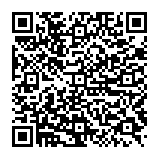
▼ Show Discussion